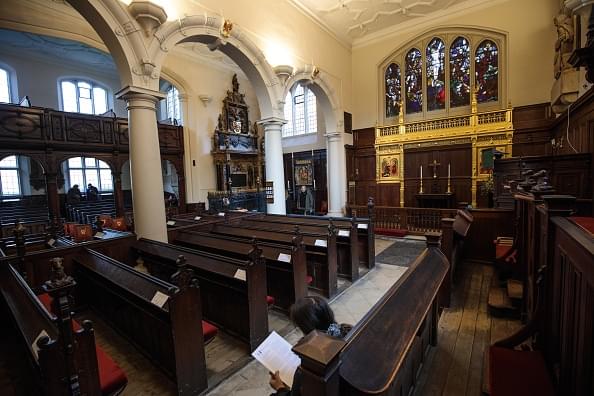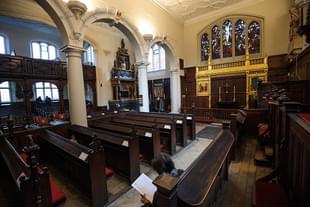Insta
Rapid Dechristianisation of Britain: Half The Population Has Turned ‘Non-Religious’, Islam On The Rise
Swarajya Staff
May 16, 2017, 03:37 PM | Updated 03:36 PM IST
Save & read from anywhere!
Bookmark stories for easy access on any device or the Swarajya app.


Britain is going into a secularisation overdrive with almost half of the population turning ‘non-religious’ or ‘nones’, a study says.
They account for 48.6 per cent of Britain’s population, says ‘The “No Religion” Population of Britain’ report.
While the number of British people identifying as Christian fell from 55 per cent to 43 per cent between 1983 and 2015, non-Christian believers quadrupled.
The official numbers also confirm the trend. From 2001 to 2011, Christians declined from 71 per cent to 59 per cent while those who identified as non-religious (or didn’t state their religion) amounted to over 32 per cent. Muslim population in the same period, increased from 2.71 per cent to 4.41 per cent while Hindus saw a modest increase of 0.37 per cent.
“The rise of the non-religious is arguably the story of British religious history over the past half-century or so,” said Stephen Bullivant, professor of theology and the sociology of religion at St Mary’s University, Twickenham, author of the report.
Although there has been an overall inclination towards secularisation in Britain, the figures also reveal record numbers of people from non-Christian faiths, such as Islam and Hinduism.
“Looking at the long-term pattern, the non-religious share of the population has shown strong growth over our whole period,” the report states.
“The year 2009 was the first in which nones outnumbered all Christians put together.
“With the single exception of 2011, this pattern has held ever after. In two years, 2009 and 2013, nones formed a majority of the adult British population.”
However, the research, carried out with data from the annual British Social Attitudes survey and the biennial European Social Survey, also highlights how the falling number of worshipers with the Church of England seems to have stabilised.
The ‘Nonverts’ Among Christians Are Higher
The research also shows a rise in the number of ‘nonverts’, namely people who have been brought up believing in a certain religion, but who have turned to be non-religious. Most ‘nonverts’ – more than six in 10 – are Christians, mainly Anglican and Catholic. According to the report, most ‘nones’ have been brought up in Christian households; overall, a mere 2 per cent of ‘nones’ have been raised in non-Christian homes. The rate of people converting to non-religion was recorded as 14 per cent for Jews, 10 per cent for Muslims and Sikhs, and 6 per cent for Hindus.
Non-Religion Is Now A Working Class Feature
Bullivant pointed out how non-religion has stopped being an exclusive middle-class feature. “It used to be middle-class people, who had gone to university, who were more likely to step out of their parents’ religiosity,” he said, as cited in the Guardian.
“As having no religion has become the norm, vast swaths of working-class people are now also identifying as nones.”
Young, White and Male Are Mostly Non-Religious
The study also shows that inner London is the most religious area of the country, mainly because of its large Muslim and migrant communities. The least religious areas are the south-east of England, Scotland and Wales. People identifying as non-religious are typically young, white and male – and increasingly working class. More men than women identify as non-religious, with a 55:45 gender split. Younger people are also more likely to reject organised religion, and nones are “significantly whiter than the British average”, says the report.
What Is Inspiring The Non-Religious Trend?
Bullivant said patriotism might be driving this trend, as Christianity and Englishness tend to be fused. “People see Christianity as an expression of Englishness. There has been more rhetoric around Britain being a Christian nation,” he said.
However, it may seem Christianity has seen a dramatic decline in Britain, but figures suggest an upward trend in recent years. Bullivant said the “growth of no religion may have stalled”. After consistent downslide, in the past few years the proportion of nones appears to have stabilised. “Younger people tend to be more non-religious, so you’d expect it to keep going – but it hasn’t.
Rentention Levels Higher In Non-Christian Religions
Non-Christian religions have significantly higher retention levels; overall, only 2 per cent of “nones” were raised in religious homes other than Christian. The “nonversion” rate was 14 per cent for Jews, 10 per cent for Muslims and Sikhs and 6 per cent for Hindus. The picture is very different for people brought up as non-religious – 92 per cent continue to identify as “nones” as adults. Conversely, the proportions of the non-religious who convert to a faith are small: 3 per cent of “cradle nones” now identify as Anglicans, less than 0.5 per cent convert to Catholicism, 2 per cent join other Christian denominations and 2 per cent convert to non-Christian faiths.
What Future Holds?
Although religious affiliation is declining in western Europe and north America, there is significant growth in other parts of the world. Islam is expected to become the world’s largest religion by 2075, and Christianity is booming in sub-Saharan Africa, Latin America and China.





